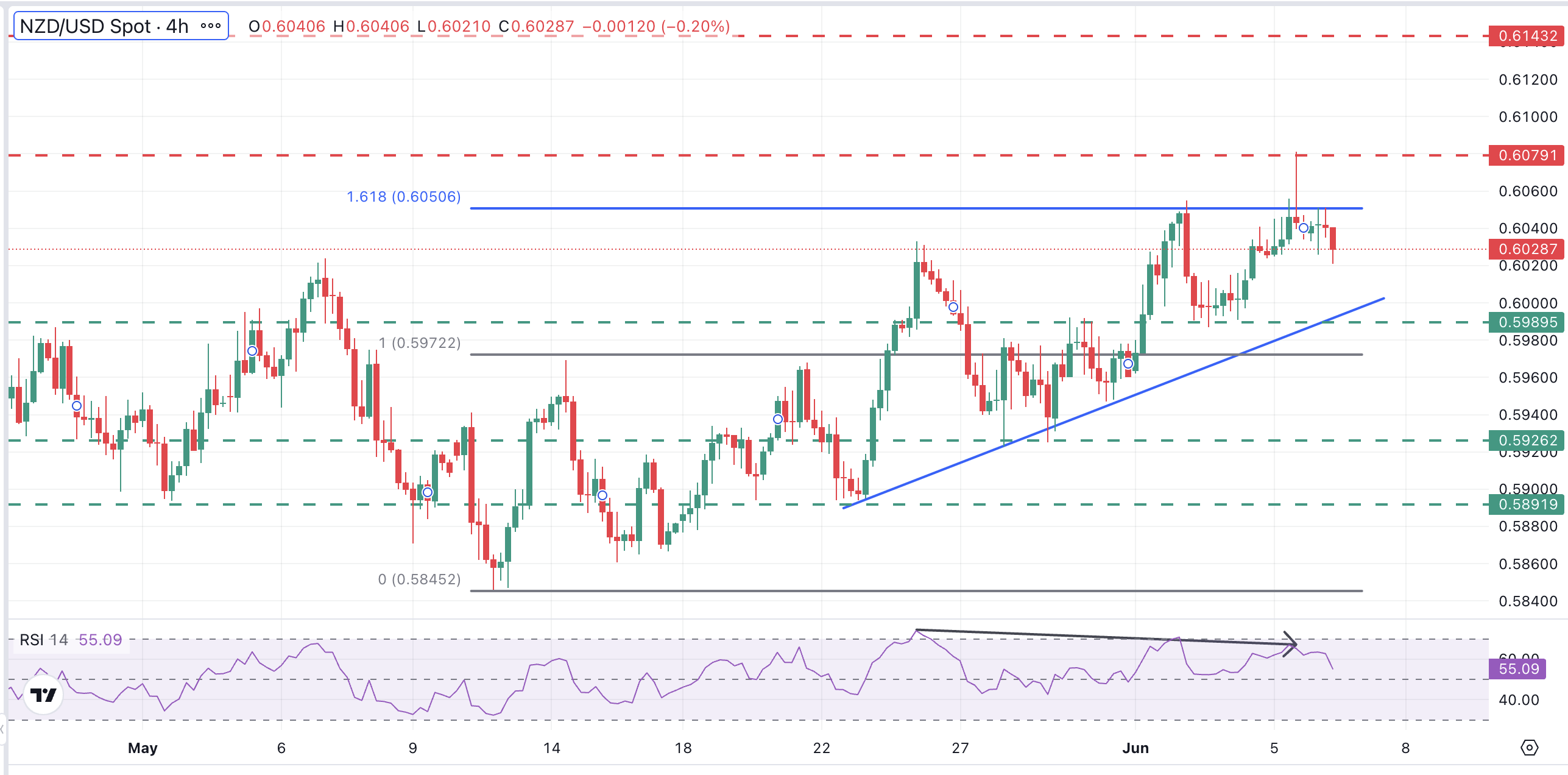NZD/USD Price Forecast: Rejection at 0.6080 brings 0.6000 back into play
- The US Dollar is trimming losses ahead of the US NFP release.
- The RSI bearish divergence suggests that the Kiwi's rally is losing steam
- NZD/USD: A break below 0.6000-0.5990 would signal a deeper correction.
New Zealand Dollar’s upside attempts were capped at 0.6180 on Thursday, and the pair is extending the reversal on Friday, against a somewhat firmer US Dollar, which brings the 0.6000 support area back into focus.
The Greenback is trimming some losses with investors unwinding their USD shorts, after a series of downbeat US releases, awaiting the US Nonfarm Payrolls Report, due later today. The market consensus anticipates a 130,000 net gain in employment in May, with the jobless rate steady at 4.2%.
Technical Analysis: A move below 0.6000 might anticipate a bearish correction
From a technical standpoint, the pair maintains the upside bias observed in the last six weeks intact, but the rejection at 0.6080 suggests that there is important resistance above 0.6050.
The 4-hour chart shows a bearish divergence on RSI studies, which suggests that the upside move is losing strength, and further downside trading below the 0.6000-0.5990 area (trendline support and June 3 lows) today would form an “Evening Star” candle pattern, a negative signal.
The next support levels below here are 0.5925 and 0.5890. On the upside, resistances are at 0.6080 and 0.6145.
NZD/USD 4-Hour Chart

New Zealand Dollar FAQs
The New Zealand Dollar (NZD), also known as the Kiwi, is a well-known traded currency among investors. Its value is broadly determined by the health of the New Zealand economy and the country’s central bank policy. Still, there are some unique particularities that also can make NZD move. The performance of the Chinese economy tends to move the Kiwi because China is New Zealand’s biggest trading partner. Bad news for the Chinese economy likely means less New Zealand exports to the country, hitting the economy and thus its currency. Another factor moving NZD is dairy prices as the dairy industry is New Zealand’s main export. High dairy prices boost export income, contributing positively to the economy and thus to the NZD.
The Reserve Bank of New Zealand (RBNZ) aims to achieve and maintain an inflation rate between 1% and 3% over the medium term, with a focus to keep it near the 2% mid-point. To this end, the bank sets an appropriate level of interest rates. When inflation is too high, the RBNZ will increase interest rates to cool the economy, but the move will also make bond yields higher, increasing investors’ appeal to invest in the country and thus boosting NZD. On the contrary, lower interest rates tend to weaken NZD. The so-called rate differential, or how rates in New Zealand are or are expected to be compared to the ones set by the US Federal Reserve, can also play a key role in moving the NZD/USD pair.
Macroeconomic data releases in New Zealand are key to assess the state of the economy and can impact the New Zealand Dollar’s (NZD) valuation. A strong economy, based on high economic growth, low unemployment and high confidence is good for NZD. High economic growth attracts foreign investment and may encourage the Reserve Bank of New Zealand to increase interest rates, if this economic strength comes together with elevated inflation. Conversely, if economic data is weak, NZD is likely to depreciate.
The New Zealand Dollar (NZD) tends to strengthen during risk-on periods, or when investors perceive that broader market risks are low and are optimistic about growth. This tends to lead to a more favorable outlook for commodities and so-called ‘commodity currencies’ such as the Kiwi. Conversely, NZD tends to weaken at times of market turbulence or economic uncertainty as investors tend to sell higher-risk assets and flee to the more-stable safe havens.

